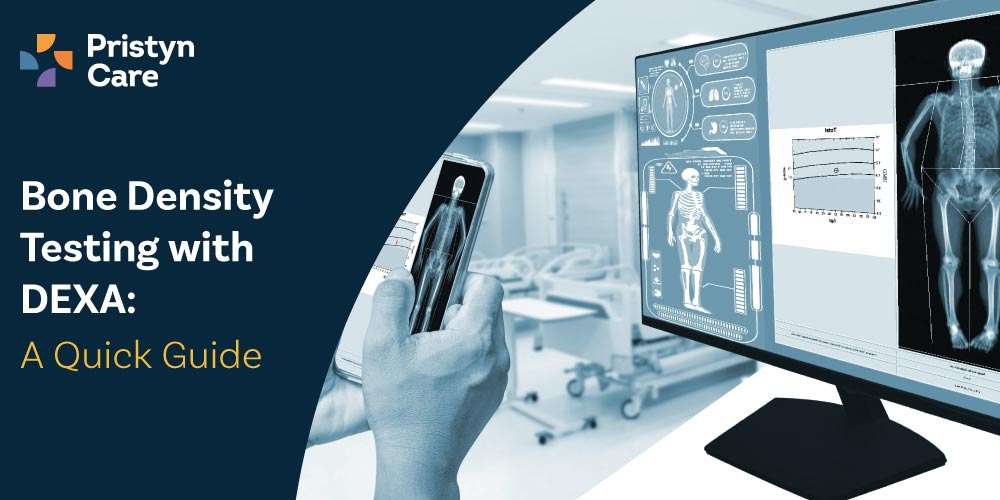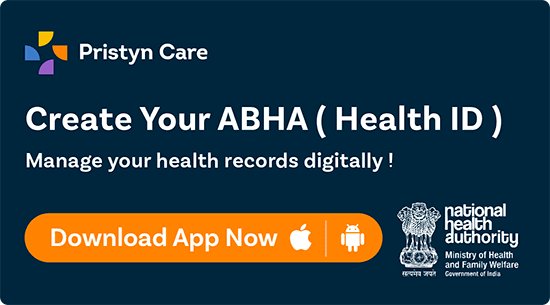
Table of Contents
What is a DEXA Scan?
A DEXA scan (dual-energy X-ray absorptiometry) is a non-invasive test to measure your bone density and assess the risk of fractures. Doctors commonly use DEXA scan to look for any signs of osteoporosis, especially in the spine and hips, common regions where bones start to weaken first.
This bone density test requires a very low dose of X-rays to form detailed images of your bones and completes within 10–20 minutes. It’s a simple outpatient procedure and doesn’t need major preparation. Your doctor asks you to avoid calcium supplements for 24 hours before the scan and let them know if you’re pregnant or recently had a contrast-based scan like a CT or barium study. Wear loose, metal-free clothing, or you may need to wear a gown.
Although some now call it a DXA scan, DEXA is a more widely recognized term. This test offers your doctor valuable details about your bone health, to enable you to take timely steps to protect it.
A DEXA Scan uses include the following:
A DEXA scan helps your doctor understand your bone strength and if you are prone to develop fractures. Orthopedists recommend bone scan if you:
- Are prone to osteoporosis or are already diagnosed
- Have had a fracture that could be related to weak bones
- Are starting or have an ongoing treatment for bone loss
- Are postmenopausal, especially if you’re above 50 years
- Have certain conditions like thyroid problems, rheumatoid arthritis, or hormonal imbalance
- Are taking medications like steroids that can affect bone strength
It’s a useful bone scan, an early step that prevents serious bone-related issues before they arise.
| T-Score | What it means |
| +1 to –1 | Normal bone density |
| –1 to –2.5 | Low bone density (osteopenia) |
| Below –2.5 | Osteoporosis (significant bone loss and risk) |
Your doctor also evaluates your Z-score, which compares your bone density to that of others your age, sex, and body size. If your Z score is too low, it indicates an underlying medical issue impacting your bone health. Understanding these scores helps you and your doctor plan a right course of action, be it lifestyle change, medications, or regular monitoring.
Types of DEXA Scans
There are different types of DEXA Scans. Depending upon what the doctor needs to assess, the bone scan targets different areas of your body. Following are the three types of DEXA Scan:
| Type of DEXA Scan | What it checks | Purpose of test |
| Centra; DEXA | Spine and hips | Most widely used type, Helps in diagnosing osteoporosis and evaluating chances of fracture |
| Peripheral DEXA | Wrist, heel, or finger | A quick screening test, can be used as an alternative if full-body equipment isn’t available |
| Whole-Body DEXA | Whole skeleton | Presents a complete picture of bone density and body composition |
Each type of DEXA scan has a unique purpose, and your doctor recommends the one best suited for your health needs.
Factors Affecting DEXA Scan Cost
The cost of a DEXA scan in India varies on the basis of several factors such as:
- Your diagnostic center’s location: DEXA scans cost more in metro cities and private hospitals than in government or smaller regional centers.
- Type of DEXA scan: A central DEXA scan (focused on spine and hips) or whole-body scan is costlier than a peripheral scan (like the wrist or heel).
- Machine quality and technology used: Advanced or digital DEXA scanners can be pricier because of their better imaging accuracy.
- Consultation or reporting fees: Some centers include the radiologist’s report in the scan package, while others keep it as an additional charge.
- Health insurance coverage: If the scan is a medical necessity, your health insurance may offer partial or full cost coverage, depending on your policy.
To avoid unexpected charges, you must ask for a clear price breakdown before your appointment.
DEXA Scan Safety and Risks
If you’ve been wondering, “Is a DEXA scan safe?”, the answer is yes. A DEXA bone scan is among the safest diagnostic imaging tests available today.
Here’s why:
- Very low radiation exposure: The level of radiation used in a DEXA scan is much lower than a common X-ray, making it safe for most people.
- Noninvasive and quick: The scan takes about 10–20 minutes and there is no use of any needles, dyes, etc.
- Not recommended for pregnant women: Though the risk is almost nil, doctors avoid DEXA scans during pregnancy unless it’s the need of the hour.
- May be affected if you had recent scans: Share with your doctor if you’ve had a barium test or a contrast CT scan recently, as it may interfere with the results.
Overall, the benefits of early bone loss detection and osteoporosis prevention outweigh the minor risks of radiation exposure.
Why Choose Pristyn Care for DEXA Scan in Hyderabad?
At Pristyn Care, we prioritize making your DEXA scan experience smooth, accurate, and stress-free. Here’s why people trust us with a thorough diagnosis procedure:
- Certified labs with NABL accreditation
- Advanced DEXA machines for credible and low-radiation scans
- Experienced radiologists for precise readings
- Flexible appointment slots, same-day and next-day options available
- End-to-end support, from booking consultation to receiving final reports
- No hidden cost, transparent pricing every time
- Insurance assistance, if the scan is a medical necessity
Whether you’re examining for osteoporosis or tracking bone health, we support you at every step of the process.
How To Prepare For Your DEXA Scan?
It is simple to prepare for DEXA scan, however a few small steps make a big difference in getting precise bone density test results. Keep the following things in mind:
- Pause calcium supplements for at least 24 hours before your DEXA scan, they can hamper with the imaging results.
- Don’t wear clothes with metal parts like zippers, buttons, hooks, as these distort the scan. Soft, loose-fitting clothes work best.
- Discuss recent test history with your doctor: If you got a barium study or a contrast-based CT scan in the last few days, let your radiologist know in advance.
- Pregnancy matters: Even though there is very low radiation involved, it’s better to inform your doctor or technician if you’re pregnant or suspect to be.
You don’t need to fast or make major lifestyle changes. However, a little prep makes sure your scan reflects your true bone health status.
What to Carry For a DEXA Scan Appointment?
A well-prepared visit makes your experience seamless and smoother. Carry the following docs while you go for a DE
- Photo ID (Aadhaar, PAN card, or any valid government-issued ID)
- Doctor’s referral or prescription, if applied
- Previous bone scan reports or relevant medical history, especially if its a follow-up scan
- Details of health insurance, if you want to claim reimbursement
- Comfortable, metal-free clothing or get ready to change into a gown at the center
These essentials help prevent delays and that your radiology team has everything they require to deliver the best outcome.
What Happens After Your DEXA Scan?
Your DEXA scan may only take a few minutes, but what happens next is where the real value lies. Once the scan is done, you can resume your routine, no recovery, no restrictions, and no downtime. But your journey to better bone health doesn’t stop there.
1. Careful evaluation of your results:
A trained radiologist analyzes your scan to measure the bone density. They generate two key scores:
- T-score – This compares the strength of your bones to that of a healthy young adult. It detects early signs of bone loss or osteoporosis.
- Z-score – This compares your bone density to people of your same age and body type. It helps in spotting unexpected patterns of bone thinning.
2. You get your report and the needed support
Your scan report is usually ready within 24–48 hours. At Pristyn Care hospitals, we make sure your report is shared with you directly and explained clearly, not just handed over. You also get to speak to the doctor if needed.
3. A plan is built around your results
If your results reflect early bone loss or osteoporosis, don’t worry a lot. It can be controlled. Your doctor may recommend:
- calcium or vitamin D supplements
- Some bone-strengthening exercises
- Adjusting certain medications
- Repeating the scan after 12–24 months for tracking progress
4. You gain clarity
A DEXA scan gives you answers. If everything comes out to be normal, you are at ease. If there’s a point of concern, you get time to act early, before symptoms show up or complications arise.
FAQs on DEXA Scan
- What exactly happens in a bone mineral density/BMD test?
A BMD test, usually done along with a DEXA scan test, checks the strength of your bones. There’s no noise, no injection, and no discomfort involved in the process. It takes between 10–20 minutes and detects early signs of bone loss, even before symptoms come.
- Is a bone density test painful?
Not at all. A DEXA scan is completely painless. It doesn’t involve needles or dyes, and you won’t feel the machine working. You only need to lie still for a few minutes. Most people find it easy, more like getting an X-ray than a medical procedure.
- What is a body composition analysis test?
A body composition analysis gives a detailed breakdown of how much of your body is made up of fat, lean muscle, and bone. Some advanced DEXA machines perform this as part of a whole-body scan. It’s useful while tracking fitness, or monitoring muscle loss with age or disease.
- Is a DEXA scan and a bone X-ray the same thing?
No, they’re different, even if they both use X-rays. A DEXA scan uses two low-dose beams for measuring bone density and spotting small changes in bone strength. A bone X-ray mainly looks for fractures and can’t detect early-stage bone loss. So, if your doctor wants to check for osteoporosis or thinning bones, they recommend a DEXA scan
- Is a DEXA scan expensive?
A DEXA scan test is affordable when you consider the detailed insight it offers. The cost differs depending upon certain factors like the lab, doctor’s consultation, etc. At Pristyn Care hospitals, our pricing is transparent and insurance if your scan is medically necessary. You’ll always know what you’re paying for.






